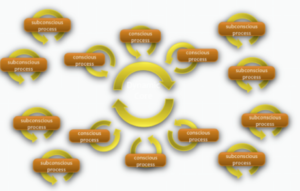(Note: This part 2 of a 3 part series of posts on Human Consciousness)
By continuously running multiple neural groups in parallel the brain is capable of processing thoughts and perceptions incredibly quickly. However not every reentrant process can or should continuously contribute to consciousness and the Dynamic Core. For example we need to notice when an object enters our visual field, but it would be a debilitating distraction if we needed to be consciously continuously observing every visual detail. Some parts of the brain are continuously monitoring these inputs from our senses but by necessity there is a process, which selectively limits them from our awareness. A synaptic threshold throttles the access of these additional reentrant processes to our conscious attention. If a process’s level of activation breaches this threshold it begins to contribute to consciousness.
 Figure 2. Subconscious processes operating in parallel outside the Dynamic Core.
Figure 2. Subconscious processes operating in parallel outside the Dynamic Core.
This is necessary because the there is limit to the resource of attention within the mind. In his Global Workspace Theory as Bernard Baars suggests, “Consciousness is closely associated with the ‘limited capacity’ aspects of the brain. Limited capacity mechanisms include immediate memory, and the selectivity of attention.”[i] Each reentrant structure is specialized to gain efficiency in a specific mode of neural processing. These circuits can be running in the background without contributing to consciousness. When one of these unconscious processes exceeds a synaptic threshold it forces some other neural circuit out of the Dynamic Core and out of our attention.
This model agrees with many of our familiar experiences. A common example is being aware that you know a fact but not being able to pull the information into your conscious mind. This “tip of the tongue” phenomenon is do to the subconscious process that has the information not being able to break the synaptic threshold to be able to contribute to the Dynamic Core of consciousness. Similarly we can change contributory neural networks by changing our physical activity, for example by taking a walk. This will alter the actively contributing core processes and can allow subconscious processes to come to the fore.
When we sleep many of the usual contributing core processes are inactivated. This allows our stream of consciousness to be dominated by cycles of thoughts normally buried deep within the subconscious. These buried processes might manifest as earworm song that continually plays in your mind, or an obsessive anxiety that is judged inconsequential in the light of day. These types of processes should not be receiving any attention at all. Normally they would not. They only can when the more important processes are shut down and not competing for the threshold of attention.
[i] Bernard J. Baars, In the Theater of Consciousness: Global Workspace Theory, A Rigorous Scientific Theory of Consciousness (Journal of Consciousness Studies 4, No. 4, 1997) 294.